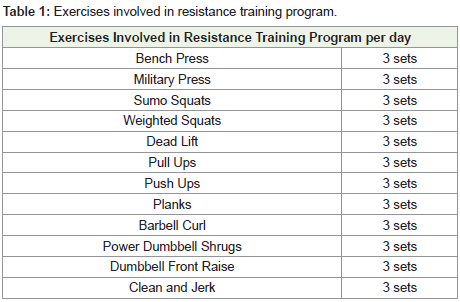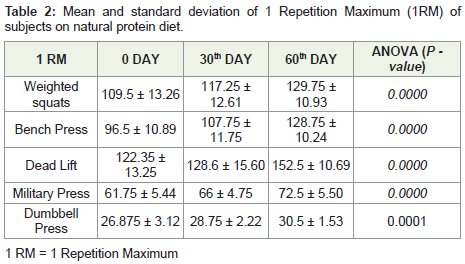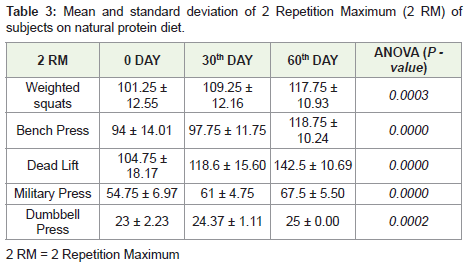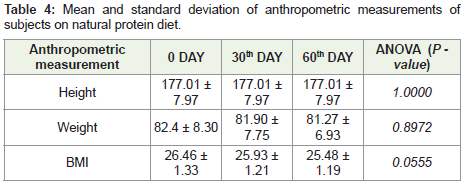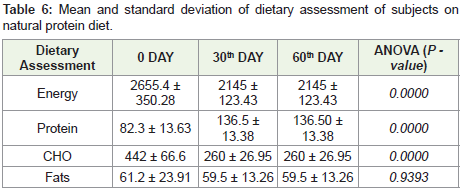Research Article
Effect of Natural Protein Intake on Strength and Body Composition of Power Athletes
Rawat L* and Sharma M
Department of Nutrition and Dietetics, Manav Rachna International Institute of Research and Studies, India
Corresponding author: Rawat L, Department of Nutrition and Dietetics, Manav Rachna International Institute of Research and Studies, Haryana-121007, India, Tel No: 9999620001; E-mail: rajputlokesh07@gmail.com
Citation: Rawat L, Sharma M. Effect of Natural Protein Intake on Strength and Body Composition of Power Athletes. Indian J Nutri. 2018;5(1): 187.
Copyright © 2018 Rawat L, et al. This is an open access article distributed under the Creative Commons Attribution License, which permits unrestricted use, distribution, and reproduction in any medium, provided the original work is properly cited.
Indian Journal of Nutrition | ISSN: 2395-2326 | Volume: 5, Issue: 1
Submission: 21/05/2018; Accepted: 26/06/2018; Published: 28/06/2018
Abstract
Power athletes perform isometric or static exercise (e.g. weight lifting) to gain strength and skeletal muscle bulk. Such exercise demands proper nutrition which can include high protein intake. Adequate nutrition not only helps to maintain the energy requirement but also can enhance their performance. The present study was conducted in Huda Market, sector-15, Faridabad, Haryana, North India with 40 adult power athletes as subjects of endurance sport, wherein 20 subjects were given natural protein diet. Two months resistance training program was given to the subjects and their strength was measured by 1 Repetition Maximum (1 RM) and 2 Repetition Maximum (2 RM). The result revealed that 1 RM the subjects on natural protein diet, strength measured by weighted squats, bench press, dead lift, military press, dumbbell press at 0 day was 109.5 ± 13.26, 96.5 ± 10.89, 122.35 ± 13.25, 61.75 ± 5.44 and 26.875 ± 3.12 respectively on the other hand at 60th day was 129.75 ± 10.93, 128.75 ± 10.24, 152.5 ± 10.69, 72.5 ± 5.50 and 30.5 ± 1.53 respectively and the differences were statistically different (p < 0.05). Regarding 2 RM of subjects on natural protein diet strength measured by weighted squats, bench press, dead lift, military press, dumbbell press at 0 day was 101.25 ± 12.55, 94 ± 14.01, 104.75 ± 18.17, 54.75 ± 6.97 and 23 ± 2.23 respectively on the other hand at 60th day 117.75 ± 10.93, 118.75 ± 10.24, 142.5 ± 10.69, 67.5 ± 5.50 and 25 ± 0.00 respectively the differences were statistically different (p < 0.05). The present study concluded that natural protein diet will have significant effect on strength of power athletes.
Keywords:
Protein diet; Power athletes; Nutrition
Introduction
Strength is the ability of a muscle or muscle group to generate force [1]. Strength is purely a measure of how much weight can be successfully lifted by an athlete. Power is the ability of a muscle or muscle group to generate force at high movement speeds. Instead of maximal weight, power is the ability to run, throw, and quickly change direction. Essentially, strength and power athletes require near maximal muscle force production [2].
Nutrition has a number of important roles for athletes competing in sports where the expression of explosive power and strength are critical to competitive success. While total energy intake of strengthpower athletes tends to be greater than that of endurance-focused athletes, intake relative to body mass is often unremarkable, with less known about distribution of nutrient intake over the day. Strengthpower athletes will benefit from a greater focus on the strategic timing of nutrient intake before, during, and after exercise to assist them in optimizing resistance training work capacity, recovery, and body composition [1].
Strength and power athletes are primarily interested in enhancing power relative to body weight and thus almost all undertake some form of resistance training. While athletes may periodically attempt to promote skeletal muscle hypertrophy, key nutritional issues are broader than those pertinent to hypertrophy and include an appreciation of the sports supplement industry, the strategic timing of nutrient intake to maximize fuelling and recovery objectives, plus achievement of pre-competition body mass requirements. Total energy and macronutrient intakes of strength-power athletes are generally high but intakes tend to be unremarkable when expressed relative to body mass. Greater insight into optimization of dietary intake to achieve nutrition-related goals would be achieved from assessment of nutrient distribution over the day, especially intake before, during, and after exercise [3].
Nutrition plays an important role in the promotion of training adaptations. According to The Institute of Medicine, 10-35% of daily calories for an average adult should come from protein, so active adults should be between 25-35%. The amount of protein that an athlete needs depends on a few factors: athletic status of the individual, their weight, intensity of exercise and the nature of their sport or activity. The FDA suggests that elite endurance athletes consume 1.2 - 1.4 g/kg body weight daily to ensure proper muscle rebuilding and structural maintenance of tissues. Weight lifters and bodybuilders require an even higher amount of protein; the FDA recommends that they receive 1.7 g/kg body weight [4]. A study done by Moore and colleagues suggest that the largest amounts of muscle protein synthesis occur when ingestion of 20 grams of high biological value protein (8-10 g essential amino acids) is ingested no more than 5-6 times daily. Timing of consumption also seems to affect protein synthesis; athletes are also encouraged to eat rapidly-digested protein meals in close proximity to their exercise training, especially during and after exercise [5].
It does appear that protein from animal sources is an important source of protein for humans from infancy until mature adulthood. However, the potential health concerns associated with a diet of protein consumed primarily from animal sources should be acknowledged. With a proper combination of sources, vegetable proteins may provide similar benefits as protein from animal sources [6].
Methodology
The present study was conducted to assess the effect of natural protein diet on strength and body composition of power athletes. The study was conducted in Huda Market, sector-15, Faridabad, Haryana, North India. Purposive sampling was done to select 20 adult male power athlete subjects of endurance sport to conduct the present study. The subjects were given Natural Protein Diet (1.6 - 1.8 g/kg). The natural protein consisted of Animal Protein (Lean Meats e.g., paneer, chicken breast, low fat fish and eggs etc.). Inclusion criteria were subjects engaged in a program of regular exercise, no difficulty in walking and running, do not use any supplement and subjects willing to participate in the study. Under Exclusion criteria, females were excluded, subjects not willing to participate, smokers, reported the history of cardiovascular, metabolic, neurological, orthopedic disorder. Two months resistance training program was given to the subjects (Table 1). Anthropometric measurements were done by using standardized tools. Strength was measured by 1 Repetition Maximum (1 RM) and 2 Repetition Maximum (2 RM). The Bioelectrical Impedance Analysis was done to measure %fat and %muscle mass with the help of Omron HBF-701, karada Scan Body Composition. Strength and body composition was measured at 0-day, 30th day and 60th day. Statistical analysis was done for Mean, Standard Deviation and ANOVA by SPSS 24 version.
Results
Table 2 depicts the mean and standard deviation of subjects on natural protein diet. At 0-day, 1 Repetition Maximum (1 RM) of weighted squats was 109.5 ± 13.26 on the other hand, on 30th day it was 117.25 ± 12.61 and 60th day it was 129.75 ± 10.93 and the difference were statistically significant (P < 0.05) i.e., strength of the subjects measured by 1RM of weighted squats enhances at 60th day as compared to 0-day by natural protein diet.
Regarding strength measured by Bench press revealed that, at 0 day, 1 RM of bench press was 96.5 ± 10.89 on the other hand, on 30th day it was 107.75 ± 11.75 and 60th day it was 128.75 ± 10.24 and the differences were statistically significant (P < 0.05) i.e., strength of the subjects measured by 1 RM of bench press enhances at 60th day as compared to 0-day by natural protein diet.
Regarding strength measured by Dead Lift revealed that, at 0-day, 1 RM of dead lift was 122.35 ± 13.25 on the other hand, on 30th day it was 128.6 ± 15.60 and 60th day it was 152.5 ± 10.69 and the difference was statistically significant (P < 0.05) i.e., strength of the subjects measured by 1 RM of dead lift enhances at 60th day as compared to 0-day by natural protein diet.
Regarding strength measured by Military Press revealed that, at 0-day, 1RM of military press was 61.75 ± 5.44 on the other hand, on 30th day it was 66 ± 4.75 and 60th day it was 72.5 ± 5.50 and the difference was statistically significant (P < 0.05) i.e., strength of the subjects measured by 1 RM of military press enhances at 60th day as compared to 0-day by natural protein diet.
Regarding strength measured by Dumbbell press revealed that, at 0-day, 1 RM of dumbbell press was 26.875 ± 3.12 on the other hand, on 30th day it was 28.75 ± 2.22 and 60th day it was 30.5 ± 1.53 and the differences were statistically significant (P < 0.05) i.e., strength of the subjects measured by 1RM of dumbbell press enhances at 60th day as compared to 0-day by natural protein diet.
Table 3 depicts the mean and standard deviation of subjects on natural protein diet. At 0-day, 2 Repetition Maximum (2 RM) of weighted squats was 101.25 ± 12.55 on the other hand, on 30th day it was 109.25 ± 12.16 and 60th day it was 117.75 ± 10.93 and the difference was statistically significant (P < 0.05) i.e., strength of the subjects measured by 2 RM of weighted squats enhances at 60th day as compared to 0-day by natural protein diet.
Regarding strength measured by Bench press revealed that, at 0-day, 2 RM of bench press was 94 ± 14.01 on the other hand, on 30th day it was 97.75 ± 11.75 and 60th day it was 118.75 ± 10.24 and the differences were statistically significant (P < 0.05) i.e., strength of the subjects measured by 2 RM of bench press enhances at 60th day as compared to 0 day by natural protein diet.
Regarding strength measured by dead lift revealed that, at 0-day, 2 RM of dead lift was 104.75 ± 18.17 on the other hand, on 30th day it was 118.6 ± 15.60 and 60th day it was 142.5 ± 10.69 and the difference was statistically significant (P < 0.05) i.e., strength of the subjects measured by 2 RM of dead lift enhances at 60th day as compared to 0-day by natural protein diet.
Regarding strength measured by military press revealed that, at 0-day, 2 RM of military press was 54.75 ± 6.97 on the other hand, on 30th day it was 61 ± 4.75 and 60th day it was 67.5 ± 5.50 and the difference was statistically significant (P < 0.05) i.e., strength of the subjects measured by 2 RM of military press enhances at 60th day as compared to 0-day by natural protein diet.
Regarding strength measured by Dumbbell press revealed that, at 0-day, 2 RM of dumbbell press was 23 ± 2.23 on the other hand, on 30th day it was 24.37 ± 1.11 and 60th day it was 25 ± 0.00 and the differences were statistically significant (P < 0.05) i.e., strength of the subjects measured by 2 RM of dumbbell press enhances at 60th day as compared to 0-day by natural protein diet.
Table 4 depicts the mean and standard deviation of subjects on natural protein diet. At 0-day, the mean height of the subjects was 177.01 ± 7.97 which remained same for the next two consecutive readings at 30th day and 60th day. And the differences were not statistically significant (P = 1.0000) i.e., the height of the subjects measured was same at 60th day as compared to 0-day by natural protein diet.
At 0-day, the mean weight of the subjects was 82.4 ± 8.30 on the other hand, on 30th day it was 81.90 ± 7.75 and 60th day it was 81.27 ± 6.93 and the difference were not statistically significant (P = 0.8972) i.e., weight of the subjects did not show any statistically significant change at 60th day as compared to 0 day by natural protein diet.
At 0-day it was 26.46 ± 1.33 on the other hand, on 30th day it was 25.93 ± 1.21 and 60th day it was 25.48 ± 1.19 and the differences were not statistically significant (P = 0.0555) i.e., the BMI of the subjects did not show any statistically significant change at 60th day as compared to 0 day by natural protein diet.
Table 5 depicts the mean and standard deviation of subjects on natural protein diet. At 0-day, the mean muscle mass% of the subjects was 31.66 ± 1.58 on the other hand, on 30th day it was 32.30 ± 1.47 and 60th day it was 32.8 ± 1.34 and the differences were not statistically significant (P = 0.578) i.e., muscle mass% of the subjects did not showed any statistically significant change at 60th day as compared to 0 day by natural protein diet.
At 0 day, the mean fat% of the subjects was 25.15 ± 2.00 on the other hand, on 30th day it was 24.31 ± 2.05 and 60th day it was 23.58 ± 1.95 and the differences were not statistically significant (P = 0.0555) i.e., fat% of the subjects did not showed any statistically significant change at 60th day as compared to 0 day by natural protein diet.
Table 6 depicts the mean and standard deviation of subjects on natural protein diet. At 0 day, the mean energy of the subjects 2655.4 ± 350.28 was on the other hand, on 30th day it was 2145 ± 123.43 and 60th day it was 2145 ± 123.43 and the difference were statistically significant (P < 0.05) i.e., the energy intake of the subjects were decreased on 60th day as compared to 0 day.
At 0 day, the mean protein of the subjects was 82.3 ± 13.63 on the other hand, on 30th day it was 136.5 ± 13.38 and 60th day it was 136.5 ± 13.38 and the difference were statistically significant (P < 0.05) i.e., the protein intake of the subjects were improved on 60th day as compared to 0 day.
At 0 day, the mean CHO of the subjects was 442 ± 66.6 on the other hand, on 30th day it was 260 ± 26.95 and 60th day it was 260 ± 26.95 and the differences were statistically significant (P < 0.05) i.e., the CHO intake of the subjects were decreased on 60th day as compared to 0 day.
At 0 day, the mean fat of the subjects was 61.2 ± 23.9 on the other hand, on 30th day it was 59.5 ± 13.26 and 60th day it was 59.5 ± 13.26 and the difference were not statistically significant (P = 0.9393) i.e., the fat intake of the subjects was same on 60th day as compared to 0 day.
Conclusion
The study concluded that, the strength of the subjects on natural protein diet measured by 1 RM, 2 RM of weighted squats, bench press, dead lift, military press, dumbbell press enhances at 60th day as compared to 0 day (P < 0.05). Regarding height, weight, BMI, they were not statistically enhanced at 60th day as compared to 0 day (P > 0.05). Regarding muscle mass% and fat%, were not statistically enhanced at 60th day as compared to 0 day (P > 0.05).
There was a significant enhancement of strength of power athletes by natural protein diet but no impact on body composition.
References
- Eberle SG (2008) Nutritional needs of endurance Athletes. Essentials of Sports Nutrition and Supplements pp: 329-349.
- Fink HH, Mikesky AE, Burgoon LA (2012) Practical applications of sports nutrition. Endurance and ultra-endurance Athletes. Jones & Bartlett Publishers Health & Fitness pp: 592.
- Maughan RJ, Shirreffs SM (2011) Journal of sports sciences. International olympic committee, lausanne, Switzerland. Supplementary issue: IOC conference on nutrition in sport. J sport sci 29: S3-S4.
- Dimke D, Ventrella M, Wilcox S (2014) The effects of whey supplementation and natural diet on protein synthesis and muscle hypertrophy pp: 1-8.
- Slater G, Phillips SM (2011) Nutrition guidelines for strength sports: sprinting, weightlifting, throwing events, and bodybuilding. J Sports Sci 29: S67-S77.
- Hoffman JR, Falvo MJ (2004) Protein - Which is best? J Sports Sci Med 3: 118-130.

